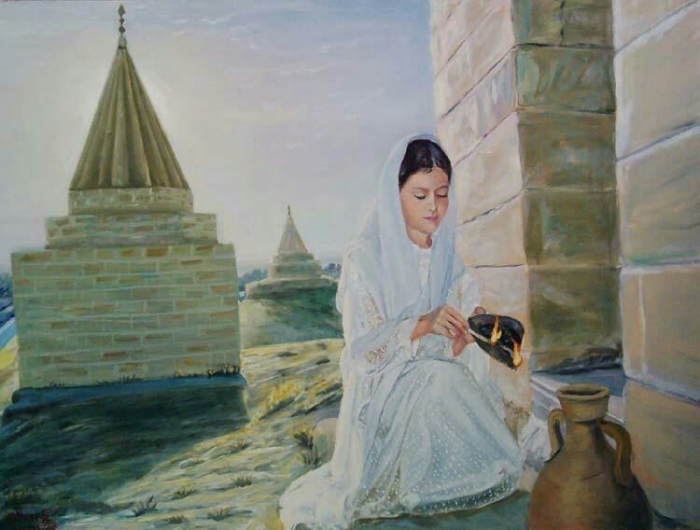How women was perceived in the Yazidi society of the 19th century. Social life

Murat Gokhan Dalyan
Cabir Dogan
Women in Social Life Unlike Armenian society, women did not isolate themselves from men or from social life, and communicated freely with men and with strangers . The British traveler and diplomat Layard found the opportunity to freely talk to and chat with Yezidi girls, and wrote about it as follows: “As I was sitting under the trees, girls gathered around me laughing, and started examining my dress and asking questions about new things that appeared strange to them. The more courageous among them would bring me their necklaces made of beads and engraved stones, and let me examine the Assyrian marks on them” . Again, unlike other Eastern women, Yezidi women are described as having well shaped bodies, black hair, black eyes and strong muscles; they covered their heads, but not their faces . Yezidi women visited the Sheikh Adi temple during certain periods of the year, just as the men did . Only married men and women were allowed to participate in the festivals . In weddings, men and women celebrated together. Layard, who made observations among the Yezidis in the 1850s, stated that he was able to communicate freely with the mir’s wives. This, however, did not mean that women were free to do whatever they liked. For example, women were supposed to cover their faces with part of their dresses if strange men stared at them . As a caste system was in place among the Yezidis, women of a higher strata in particular were treated with respect by both men and women of the lower strata . Women from emir families had a say in the ruling of their societies, and even ruled their societies from time to time. All the decrees issued by Yezidi Emir Said Bey in 1935 bore his mother’s signature, which meant it was actually his mother who ruled the community . It was also observed that some Yezidi women smoked, and did not feel the need to try to hide it. As literacy was forbidden among Yezidis, both women and men were illiterate. The right to learn how to read and write was given only to two religious men, with the purpose of protecting religious texts and making use of them when necessary . However, in 1909, Yezidi Mir İsmail Bey encouraged the opening and attendance of schools, and partially succeeded in breaking this prejudice against education, especially among men . Despite his efforts, lack of education among women was widespread throughout the 20th century, due to the idea that the duty of women is to run the household, not to learn how to read and write . Thus, the level of education among the women is very low. The lower social status accorded to women began at birth and continued throughout their lives. When a woman gave birth to a boy, his parents gave presents and sacrifice animals. If the child born was a girl, on the other hand, a deep silence prevailed in the house . Women were supposed to follow their husbands a couple of steps behind when walking, and leave their seats to men if men were standing. If there were both men and women in a gathering, women were supposed to be serving. Girls were brought up in accordance with these norms from a very early age onwards . Childhood ended at age 4 to 5 for Yezidi girls, who then had to shoulder part of the household work. Girls were married at a very early age, and became mothers very young . Because a patriarchal social system was in place, women were the last adults to express their ideas concerning family matters. They lived under the orders and commands of their fathers and brothers when single, and under the directives of their husbands once they were married. When the husband died, it was the oldest son who became the head of the household. The main tasks performed by women were household duties and care of animals . Dinner etiquette required that women make the dinner ready for the whole family, but did not sit at the same table as the men; they ate their dinner at a separate table after serving the men’s meals. Although sitting separately was not as strict a rule among Yezidis as it was among other Middle Eastern societies, men and women still had their own private living spaces in their dwellings . Female-only sections were prepared within the tents, separated from the men’s section by reed fences . As required by their faith, women, like the men, had an “other-worldly brother” with which they were forbidden to marry. These brothers, usually from another stratum, would be treated like real brothers and the women would mingle with them freely . Layard observed that Yezidi women were fond of cleanliness and took frequent baths . Similarly, Forbes observed that Yezidi houses were kept very neat and clean . In August each year, the Yezidis, both men and women, gathered around the shrine of Sheikh Adi, sang songs, danced, and celebrated all night long. Only married men and women were allowed at these celebrations. At the end of the night, all fires were put out and everyone retreated into seclusion. These celebrations became the source of various rumors about the Yezidis . On this subject, Layard’s testimony is as follows: “I have not seen or heard of anything negative about them that would change the good impression they left me with.”
Yezidi women, from time to time, were abducted for marriage by their Muslim neighbors. However, such incident became rare towards the end of the 19th century thanks to measures taken by the state . The favorite color among Yezidi women is dark red, which figures prominently in their dresses, fabrics and jewelry. The only color not liked in the Yezidi society and subsequently never worn is blue. A Yezidi wearing blue is thus a rarity . The story behind the prohibition concerning the color blue has something to do with a dream a Yezidi had about people wearing blue . Women were known to be especially fond of wearing white linen and headscarves . The most common dress was a tunic, which almost reached the heels. Yezidi women also wore a rectangular shaped mantle that ran from their left shoulder to under their right arm. There was nothing that would differentiate them from the Turkish, Chaldean, Arab or Kurdish women in the region, except that they did not wear a veil or otherwise cover their faces . In his Seyahatname, Evliya Çelebi reports that Yezidi women wore colorful dresses and kept their hair so long that it reached their feet . Yezidi women covered their heads and their necks. In addition, some of them had Kofis/head dresses that ran from their temples and were knotted under their chins with ribbons upon them . These Kofis/head dresses were sometimes decorated with gold and silver coins . It is also known that some wore short sleeved shirts above their dresses, wore kerchiefs around their necks, and wore lots of jewelry, such as rings, necklaces and bracelets. Throughout the 19th century, women were more conservative with regards to dress compared to men. Men started to adopt Western dress codes towards the end of the century, whereas women mostly kept their traditional dresses . Yezidi women were able to freely talk to men and communicate freely within the society and they covered their faces using part of their dress only when strange men stared at them. Single women in particular dressed the way they liked, but married women mostly wore white clothes . Besides rings and bracelets, necklaces made of beads or engraved stones were also very common among Yezidi women . Jewelry worn by women sometimes reflected their desires. For example, newly-wed Yezidi women in Caucasia wore long earrings in the shape of a cucumber because this was believed to help with getting pregnant . Among wealthy families, belts decorated with pieces of silver were also part of the jewelry of women . Besides jewelry, girls used to wear various flowers in their hair . At the beginning of April in particular, which is the beginning of the official Yezidi New Year, girls went up the mountains, and decorated their hair, houses and doors with the flowers they had gathered. G.R. Driver reports that red flowers were the most preferred.
Tags: #yazidisinfo #yezidi #aboutyezidis
How women was perceived in the Yazidi society of the 19th century. Social life

Murat Gokhan Dalyan
Cabir Dogan
Women in Social Life Unlike Armenian society, women did not isolate themselves from men or from social life, and communicated freely with men and with strangers . The British traveler and diplomat Layard found the opportunity to freely talk to and chat with Yezidi girls, and wrote about it as follows: “As I was sitting under the trees, girls gathered around me laughing, and started examining my dress and asking questions about new things that appeared strange to them. The more courageous among them would bring me their necklaces made of beads and engraved stones, and let me examine the Assyrian marks on them” . Again, unlike other Eastern women, Yezidi women are described as having well shaped bodies, black hair, black eyes and strong muscles; they covered their heads, but not their faces . Yezidi women visited the Sheikh Adi temple during certain periods of the year, just as the men did . Only married men and women were allowed to participate in the festivals . In weddings, men and women celebrated together. Layard, who made observations among the Yezidis in the 1850s, stated that he was able to communicate freely with the mir’s wives. This, however, did not mean that women were free to do whatever they liked. For example, women were supposed to cover their faces with part of their dresses if strange men stared at them . As a caste system was in place among the Yezidis, women of a higher strata in particular were treated with respect by both men and women of the lower strata . Women from emir families had a say in the ruling of their societies, and even ruled their societies from time to time. All the decrees issued by Yezidi Emir Said Bey in 1935 bore his mother’s signature, which meant it was actually his mother who ruled the community . It was also observed that some Yezidi women smoked, and did not feel the need to try to hide it. As literacy was forbidden among Yezidis, both women and men were illiterate. The right to learn how to read and write was given only to two religious men, with the purpose of protecting religious texts and making use of them when necessary . However, in 1909, Yezidi Mir İsmail Bey encouraged the opening and attendance of schools, and partially succeeded in breaking this prejudice against education, especially among men . Despite his efforts, lack of education among women was widespread throughout the 20th century, due to the idea that the duty of women is to run the household, not to learn how to read and write . Thus, the level of education among the women is very low. The lower social status accorded to women began at birth and continued throughout their lives. When a woman gave birth to a boy, his parents gave presents and sacrifice animals. If the child born was a girl, on the other hand, a deep silence prevailed in the house . Women were supposed to follow their husbands a couple of steps behind when walking, and leave their seats to men if men were standing. If there were both men and women in a gathering, women were supposed to be serving. Girls were brought up in accordance with these norms from a very early age onwards . Childhood ended at age 4 to 5 for Yezidi girls, who then had to shoulder part of the household work. Girls were married at a very early age, and became mothers very young . Because a patriarchal social system was in place, women were the last adults to express their ideas concerning family matters. They lived under the orders and commands of their fathers and brothers when single, and under the directives of their husbands once they were married. When the husband died, it was the oldest son who became the head of the household. The main tasks performed by women were household duties and care of animals . Dinner etiquette required that women make the dinner ready for the whole family, but did not sit at the same table as the men; they ate their dinner at a separate table after serving the men’s meals. Although sitting separately was not as strict a rule among Yezidis as it was among other Middle Eastern societies, men and women still had their own private living spaces in their dwellings . Female-only sections were prepared within the tents, separated from the men’s section by reed fences . As required by their faith, women, like the men, had an “other-worldly brother” with which they were forbidden to marry. These brothers, usually from another stratum, would be treated like real brothers and the women would mingle with them freely . Layard observed that Yezidi women were fond of cleanliness and took frequent baths . Similarly, Forbes observed that Yezidi houses were kept very neat and clean . In August each year, the Yezidis, both men and women, gathered around the shrine of Sheikh Adi, sang songs, danced, and celebrated all night long. Only married men and women were allowed at these celebrations. At the end of the night, all fires were put out and everyone retreated into seclusion. These celebrations became the source of various rumors about the Yezidis . On this subject, Layard’s testimony is as follows: “I have not seen or heard of anything negative about them that would change the good impression they left me with.”
Yezidi women, from time to time, were abducted for marriage by their Muslim neighbors. However, such incident became rare towards the end of the 19th century thanks to measures taken by the state . The favorite color among Yezidi women is dark red, which figures prominently in their dresses, fabrics and jewelry. The only color not liked in the Yezidi society and subsequently never worn is blue. A Yezidi wearing blue is thus a rarity . The story behind the prohibition concerning the color blue has something to do with a dream a Yezidi had about people wearing blue . Women were known to be especially fond of wearing white linen and headscarves . The most common dress was a tunic, which almost reached the heels. Yezidi women also wore a rectangular shaped mantle that ran from their left shoulder to under their right arm. There was nothing that would differentiate them from the Turkish, Chaldean, Arab or Kurdish women in the region, except that they did not wear a veil or otherwise cover their faces . In his Seyahatname, Evliya Çelebi reports that Yezidi women wore colorful dresses and kept their hair so long that it reached their feet . Yezidi women covered their heads and their necks. In addition, some of them had Kofis/head dresses that ran from their temples and were knotted under their chins with ribbons upon them . These Kofis/head dresses were sometimes decorated with gold and silver coins . It is also known that some wore short sleeved shirts above their dresses, wore kerchiefs around their necks, and wore lots of jewelry, such as rings, necklaces and bracelets. Throughout the 19th century, women were more conservative with regards to dress compared to men. Men started to adopt Western dress codes towards the end of the century, whereas women mostly kept their traditional dresses . Yezidi women were able to freely talk to men and communicate freely within the society and they covered their faces using part of their dress only when strange men stared at them. Single women in particular dressed the way they liked, but married women mostly wore white clothes . Besides rings and bracelets, necklaces made of beads or engraved stones were also very common among Yezidi women . Jewelry worn by women sometimes reflected their desires. For example, newly-wed Yezidi women in Caucasia wore long earrings in the shape of a cucumber because this was believed to help with getting pregnant . Among wealthy families, belts decorated with pieces of silver were also part of the jewelry of women . Besides jewelry, girls used to wear various flowers in their hair . At the beginning of April in particular, which is the beginning of the official Yezidi New Year, girls went up the mountains, and decorated their hair, houses and doors with the flowers they had gathered. G.R. Driver reports that red flowers were the most preferred.
Tags: #yazidisinfo #yezidi #aboutyezidis

























